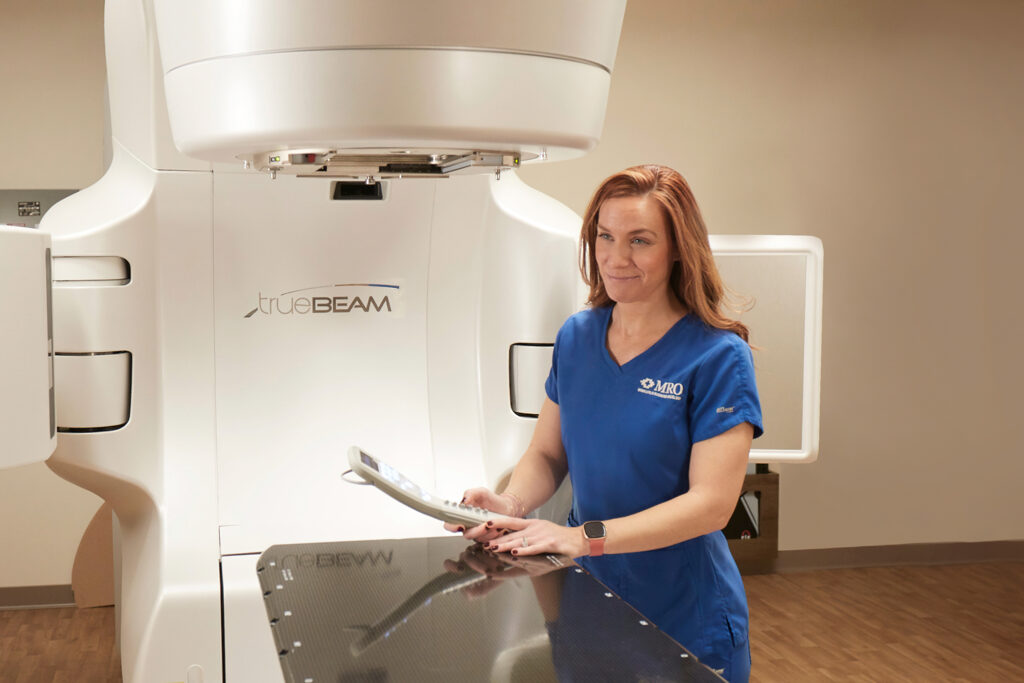Uterine Cancer Treatment Options
Fighting uterine cancer with pinpoint accuracy.
At MRO, we use radiation, or radiotherapy, to destroy cancer cells with radiation. Using state-of-the-art imaging technologies such as MRI, CT, and PET, your MRO care team can pinpoint radiation doses down to the millimeter.
 The way the radiation therapy is given depends on the type and stage of the cancer being treated. But each treatment directs precise doses of radiation at cancer cells, which are more susceptible to radiation than healthy cells. Like an x-ray, radiation therapy is painless. For patients who receive external beam radiation therapy, there’s no fear of becoming radioactive during or after treatment.
The way the radiation therapy is given depends on the type and stage of the cancer being treated. But each treatment directs precise doses of radiation at cancer cells, which are more susceptible to radiation than healthy cells. Like an x-ray, radiation therapy is painless. For patients who receive external beam radiation therapy, there’s no fear of becoming radioactive during or after treatment.
Once your MRO radiation oncologist has examined you, he or she will discuss treatment options and the pros and cons of radiation treatment, and determine the dosage, technique, and type of radiation to be used for your treatment. Your MRO care team will help explain treatment, discuss how sessions are scheduled, and provide information on how to take care of yourself during treatment. You’ll also meet with your MRO care team each week to monitor progress and answer any questions you may have.
Since radiotherapy for uterine cancer requires the utmost precision, you’ll also go through a simulation at the MRO Therapy Center. Using image mapping as a guide, your care team will position you as you would be for treatment and take measurements to build a targeted treatment plan and pinpoint the radiation for the best possible outcome.
For endometrial cancer, radiation therapy is used most often after surgery to kill any remaining cancer cells. If your treatment plan includes radiation after surgery, you will have several weeks to heal before treatment.
Radiation may be used to treat uterine cancer:
- Before surgery to make it easier to remove all the cancer.
- After surgery to help lower the chance of the cancer coming back in the pelvis.
- As the main treatment, if you can’t have surgery because of other health problems.
- To shrink a tumor that’s causing pain and swelling by pressing on nerves and blood vessels.
Sometimes chemotherapy is given along with the radiation to help it work better. This is called chemoradiation.
For uterine cancer treatment, MRO specialists use two types of radiation therapy:
External beam radiation therapy (EBRT): This is the most common form of radiation treatment. EBRT delivers radiation to the uterine cancer cells from outside the body using a machine called a linear accelerator (LINAC) to direct high-energy radiation beams to the precise location of the cancer. External beam radiation therapy is often given five days a week for four to six weeks. The skin around the treatment area is carefully marked with permanent ink or tiny tattoos. A custom-made mold for your pelvis and lower back is sometimes used to make sure you’re in the exact same position for each treatment. Each treatment takes less than a half-hour, but daily visits to the radiation center are needed.
Brachytherapy (internal radiation therapy): Women who have had their uterus (and cervix) removed may have the upper part of the vagina treated with brachytherapy. A radiation source is put into a cylinder (called an applicator) and the cylinder is put into the vagina. (It feels a lot like a snug tampon.) There are 2 types of brachytherapy used for endometrial cancer, low-dose rate (LDR) and high-dose rate (HDR).
- In LDR brachytherapy, the applicator with the radiation source in it is left in for about 1 to 4 days. You’ll need to be still to keep the applicator from moving during treatment, so you usually need to stay in the hospital.
- In HDR brachytherapy, the radiation is stronger. Each treatment takes a very short time, and the radiation is only in for 10 to 20 minutes. The applicator is only in place while the treatment is done. You’ll be able to go home the same day. For endometrial cancer, HDR brachytherapy might be given weekly or even daily for at least 3 doses.
During brachytherapy, you may experience changes in the lining of the vagina. If needed, pain medicines can be used to help you be more comfortable while the applicator is in.
In some cases, both internal brachytherapy and external beam radiation therapy are used. In those instances, the external beam radiation is usually given first, followed by the brachytherapy.
The stage and grade of your particular cancer dictates which area needs to be treated with radiation therapy and which types of radiation we use. Although every woman’s journey is unique, most receive treatments five days a week for one to eight weeks. Your own treatment schedule will be specifically tailored to you.